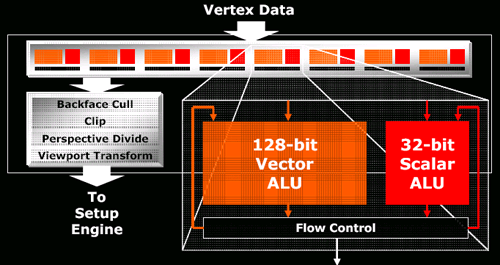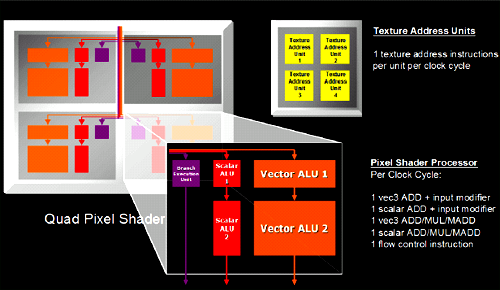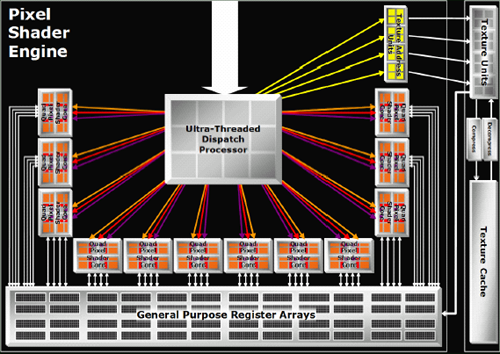ATI's New Leader in Graphics Performance: The Radeon X1900 Series
by Derek Wilson & Josh Venning on January 24, 2006 12:00 PM EST- Posted in
- GPUs
R580 Architecture
The architecture itself is not that different from the R520 series. There are a couple tweaks that found their way into the GPU, but these consist mainly of the same improvements made to the RV515 and RV530 over the R520 due to their longer lead time (the only reason all three parts arrived at nearly the same time was because of a bug that delayed the R520 by a few months). For a quick look at what's under the hood, here's the R520 and R580 vertex pipeline:

and the internals of each pixel quad:

The real feature of interest is the ability to load and filter 4 texture addresses from a single channel texture map. Textures which describe color generally have four components at every location in the texture, and normally the hardware will load an address from a texture map, split the 4 channels and filter them independently. In cases where single channel textures are used (ATI likes to use the example of a shadow map), the R520 will look up the appropriate address and will filter the single channel (letting the hardware's ability to filter 3 other components go to waste). In what ATI calls it's Fetch4 feature, the R580 is capable of loading 3 other adjacent single channel values from the texture and filtering these at the same time. This effectively loads 4 and filters four times the texture data when working with single channel formats. Traditional color textures, or textures describing vector fields (which make use of more than one channel per position in the texture) will not see any performance improvement, but for some soft shadowing algorithms performance increases could be significant.
That's really the big news in feature changes for this part. The actual meat of the R580 comes in something Tim Allen could get behind with a nice series of manly grunts: More power. More power in the form of a 384 million transistor 90nm chip that can push 12 quads (48 pixels) worth of data around at a blisteringly fast 650MHz. Why build something different when you can just triple the hardware?

To be fair, it's not a straight tripling of everything and it works out to look more like 4 X1600 parts than 3 X1800 parts. The proportions work out to match what we see in the current midrange part: all you need for efficient processing of current games is a three to one ratio of pixel pipelines to render backends or texture units. When the X1000 series initially launched, we did look at the X1800 as a part that had as much crammed into it as possible while the X1600 was a little more balanced. Focusing on pixel horsepower makes more efficient use of texture and render units when processing complex and interesting shader programs. If we see more math going on in a shader program than texture loads, we don't need enough hardware to load a texture every single clock cycle for every pixel when we can cue them up and aggregate requests in order to keep available resources busy more consistently. With texture loads required to hide latency (even going to local video memory isn't instantaneous yet), handling the situation is already handled.
Other than keeping the number of texture and render units the same as the X1800 (giving the X1900 the same ratios of math to texture/fill rate power as the X1600), there isn't much else to say about the new design. Yes, they increased the number of registers in proportion to the increase in pixel power. Yes they increased the width of the dispatch unit to compensate for the added load. Unfortunately, ATI declined allowing us to post the HDL code for their shader pipeline citing some ridiculous notion that their intellectual property has value. But we can forgive them for that.
This handy comparison page will have to do for now.
The architecture itself is not that different from the R520 series. There are a couple tweaks that found their way into the GPU, but these consist mainly of the same improvements made to the RV515 and RV530 over the R520 due to their longer lead time (the only reason all three parts arrived at nearly the same time was because of a bug that delayed the R520 by a few months). For a quick look at what's under the hood, here's the R520 and R580 vertex pipeline:

and the internals of each pixel quad:

The real feature of interest is the ability to load and filter 4 texture addresses from a single channel texture map. Textures which describe color generally have four components at every location in the texture, and normally the hardware will load an address from a texture map, split the 4 channels and filter them independently. In cases where single channel textures are used (ATI likes to use the example of a shadow map), the R520 will look up the appropriate address and will filter the single channel (letting the hardware's ability to filter 3 other components go to waste). In what ATI calls it's Fetch4 feature, the R580 is capable of loading 3 other adjacent single channel values from the texture and filtering these at the same time. This effectively loads 4 and filters four times the texture data when working with single channel formats. Traditional color textures, or textures describing vector fields (which make use of more than one channel per position in the texture) will not see any performance improvement, but for some soft shadowing algorithms performance increases could be significant.
That's really the big news in feature changes for this part. The actual meat of the R580 comes in something Tim Allen could get behind with a nice series of manly grunts: More power. More power in the form of a 384 million transistor 90nm chip that can push 12 quads (48 pixels) worth of data around at a blisteringly fast 650MHz. Why build something different when you can just triple the hardware?
To be fair, it's not a straight tripling of everything and it works out to look more like 4 X1600 parts than 3 X1800 parts. The proportions work out to match what we see in the current midrange part: all you need for efficient processing of current games is a three to one ratio of pixel pipelines to render backends or texture units. When the X1000 series initially launched, we did look at the X1800 as a part that had as much crammed into it as possible while the X1600 was a little more balanced. Focusing on pixel horsepower makes more efficient use of texture and render units when processing complex and interesting shader programs. If we see more math going on in a shader program than texture loads, we don't need enough hardware to load a texture every single clock cycle for every pixel when we can cue them up and aggregate requests in order to keep available resources busy more consistently. With texture loads required to hide latency (even going to local video memory isn't instantaneous yet), handling the situation is already handled.
Other than keeping the number of texture and render units the same as the X1800 (giving the X1900 the same ratios of math to texture/fill rate power as the X1600), there isn't much else to say about the new design. Yes, they increased the number of registers in proportion to the increase in pixel power. Yes they increased the width of the dispatch unit to compensate for the added load. Unfortunately, ATI declined allowing us to post the HDL code for their shader pipeline citing some ridiculous notion that their intellectual property has value. But we can forgive them for that.
This handy comparison page will have to do for now.










120 Comments
View All Comments
ChronoReverse - Tuesday, January 24, 2006 - link
Indeed. My 6800LE cost $129 and unlocked, gets pretty close to 6800GT speeds.Obviously not as good, but still pretty damn good and I paid a lot less too.
It's been like this since the TNT2 M64 came out.
mi1stormilst - Tuesday, January 24, 2006 - link
I am taking issue with ATI and Anandtech on this one:1.) The bloody X1800 series is pretty dang new, they are taking about phasing it out when I have not even had a chance to use the AVIO video tool yet WTF!?
2.) The section of the article "Performance Breakdown" http://anandtech.com/video/showdoc.aspx?i=2679&...">http://anandtech.com/video/showdoc.aspx?i=2679&... is very misleading to say the least. I think you owe the readers an explination at how you arrived at those numbers? Did you test at one resolution? Only testing for a resolution that allows the ATI card the advantadge is hardly fair. I know a lot of gamers including myself that still generally game at 1024x768 how do the cards fair at that resolution? What are the real differences overall? I think you should either pull this out of the article all together or test at least 3 common resolutions (1024x768) (1280x1024) & (1600x1200).
Just my two cents.
GTMan - Tuesday, January 24, 2006 - link
Yes, your card is now out of date. You should stop using it. I'll give you $5 for it if that would make you feel better.mi1stormilst - Wednesday, January 25, 2006 - link
HAHA! My kid 8 year old kid will inherit the X1800XL in a few months after I order the X1900XT. I bet that bothers you ... no? (-;beggerking - Tuesday, January 24, 2006 - link
I 2nd that!!b/w, this is a repost. lol.. see my comments above..
DerekWilson - Tuesday, January 24, 2006 - link
I appreciate your comments.The point about the X1800 is well taken. It would be hard for us to expect them to push back their "refresh" part because they dropped the ball on the R520. And it also doesn't make economic sense to totally scrap the R520 before it gets out the door.
It was a tough sitation. At lesat ATI didn't take as much of a bath on the R520 as NVIDIA did on NV30 ...
But again, I certainly understand your sentiment.
Second, I did explain where the numbers came from. 2048x1536 with 4xAA in each game. The graph mentions that we calculated percent increase to x1900 performance -- which means our equation looks like this --
((x1900 score) - (competing score)) / competing score * 100
if you game at 1024x768, you have absolutely no business buying a $600 video card.
again ... ^^
we did test 12x10 and 16x12 and people who want those results can easily see them on each game test page.
This is a high end card and it seems like the best fit to describe performance is a high end test. If we did a 1024x768 test it would just be an exercise in observing the cpu overhead of the driver and how well the fx57 was able to handle it.
Our intention is not to mislead. But people often want a quick overview, and detail and acuracy are fundamentally at odds with the idea of a quick and easy demonstration. Our understanding is that people interested in this card are intereted in high quality, high res performance, so this cross section of performance seemed the most logical.
mi1stormilst - Wednesday, January 25, 2006 - link
Thanks for responding (-:I do think benchmarking at 1024x768 is perfectly valid. I for one game at 1024x768 with all the candy turned on so not only can I enjoy my looks of the game but I can still render high frames while playing online. When I want to enjoy the single player option I am willing to let the frames dive down to the bare minimums so I can enjoy all that the game has to offer without getting lag killed. So I think that justifys my reasons to want a $600.00 video card (-;
Although I was slightly incorrect about how you benchmarked I stand by my feeling that is is not a TRUE representation of the cards performance across the board. It is a snapshot which leaves a lot of holes unfilled. I would feel cheated as a customer to find that it did not perform as well as I had been lead to believe if the way I wanted to use it was not optimized as well as another way. Understood?
Thanks for the time you have spent evaluating it...it does give us an overall feeling and of course when I am looking at spending that kind of money you can bet I will be doing a lot more then reading one review (-:
Garrett
beggerking - Tuesday, January 24, 2006 - link
It is kind of misleading since Nvidia leads in max quality test in a few games, but the advantage is still given to ATI.x1900xtx is a better performing card overall, but it is not THAT much better. quite an exaggeration.
blahoink01 - Tuesday, January 24, 2006 - link
It would be nice to see World of Warcraft included in the benchmark set. Considering it is probably the most popular game in the world, I'm sure many readers would find the benchmarks useful.fishbits - Tuesday, January 24, 2006 - link
Why, was the WoW engine changed recently? It's easy to max out WoW display settings on far less capable cards, so what useful information would come from benchmarking it with bleeding edge gear? Unless maybe you're running it on some massive $3000 monitor, in which case upgrading to a 300-500 dollar video card should be a no-brainer. The only useful benchmark would be "How would my older video card handle WoW?" and that's already been done. Must be missing something here.